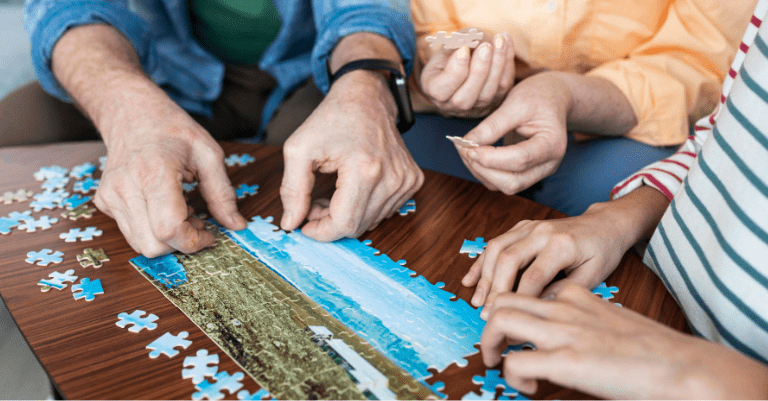Catastrophic neurological injuries leave a lasting impact on the body and mind. After sustaining a brain or spinal cord injury, some patients have trouble balancing, moving their limbs, speaking, seeing, and hearing. In addition to physical impairments, cognitive deficits in the realms of attention, memory, problem-solving, reasoning, planning, and social interaction can make it extremely difficult for brain injury survivors to navigate and enjoy their lives.
In this article, we’ll look at the role of cognitive therapy in brain injury rehabilitation and explore the five cognitive domains this type of therapy can treat.
What is cognitive therapy?
Cognitive therapy, also known as cognitive rehabilitation therapy, combines a range of methods designed to improve cognitive function following neurological trauma, such as brain or spinal cord injury. Through repetitive, long-term practice, cognitive therapy can help restore mental dexterity and reduce dependence on compensatory strategies.
Patients who struggle with short- or long-term memory, for example, might develop a note-taking habit to help them remember important details. While this could offer a serviceable temporary solution, such strategies can be unsustainable in the long run. Cognitive therapy seeks to restore the brain’s own ability to encode information through regular memory exercises.
What are examples of cognitive therapy?
Mental rehabilitation typically targets five distinct cognitive domains: attention and concentration, memory, problem-solving and reasoning, executive functioning, and social communication and cognition. While every patient’s therapeutic plan is unique, certain strategies are especially well suited to each domain. Let’s look at a few examples of cognitive therapy within these categories.
Attention and concentration
Brain injury patients often struggle to process information — a critical skill for independent adults living in a fast-paced world. After a neurological injury, alertness, awareness, arousal, and sensory processing can all be compromised. Some people also experience restlessness, inattention, and difficulty multitasking or finishing projects.
To strengthen these skills, cognitive therapists may assist patients in completing computer work that requires reasoning and concentration. Listening to presentations and playing games can also help to strengthen neural networks necessary for attention and processing.
Memory
Catastrophic neurological injuries can severely impact the brain’s ability to encode and store information, resulting in trouble learning and recalling information, events, or conversations.
There are a number of cognitive activities that can improve memory over time. Examples include external strategies, such as timers, lists, and notes, as well as internal memorization techniques, like mnemonic devices and acronyms. Cognitive therapists may also encourage patients to keep a memory notebook, complete worksheets, practice common activities, or rehearse safety procedures associated with everyday tasks.
Problem-solving and reasoning
Identifying problems, considering consequences, developing logical solutions, setting goals, and self-evaluation — all of these skills require the capacity to reason and problem-solve. When brain injury patients struggle in this domain, cognitive therapists rely on a range of techniques, depending on the patient’s needs and interests. Reason-strengthening therapeutic exercises might include gardening, auto mechanics, vocations, goal-setting, and working in groups.
Executive functioning
This domain includes higher-level cognitive processes such as managing one’s thoughts and feelings, maintaining awareness of time, and thinking abstractly. When executive functioning is impaired, planning, organization, and following a series of complex steps or instructions can become extremely laborious.
To promote cognitive rehabilitation in this domain, therapists may have patients complete computer tasks, create documents, answer phone calls, engage in scheduling exercises, use tools, or even take on responsibilities such as holding a job.
Social communication and cognition
Families are often most keenly aware of social behavioral changes in loved ones who have been through a neurological trauma. Many patients experience a decrease in inhibition and behavioral control, resulting in the expression of inappropriate or insensitive thoughts, feelings, and actions.
To improve social communication and cognition skills, patients may be encouraged to play games, interact in social groups, exercise with other patients, engage in community outings, dine at restaurants, and analyze video recordings to practice social awareness and perception.
How to improve cognitive function during brain injury rehabilitation
Recovering from a neurological injury is a highly personal process. No two patients are exactly alike, which is why treatment plans should be tailored to the unique needs, goals, and challenges of the individual. For many, cognitive therapy offers an invaluable set of methods, which patients and therapists can draw from in the creation of individualized plans.
Depending on the severity of the injury, residential treatment may provide the most efficient and effective path to recovery. The Nexus Rise Program offers adults a highly supportive environment for brain injury rehabilitation. Contact Nexus to learn more about this life-changing program.

